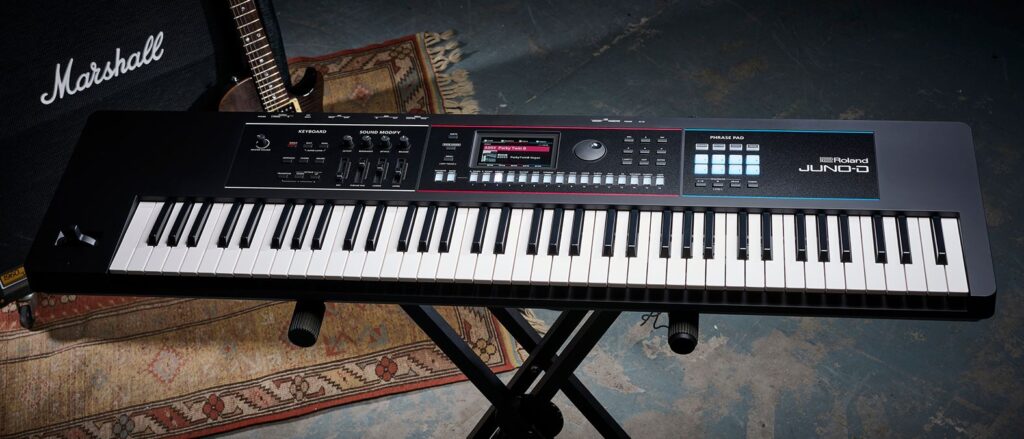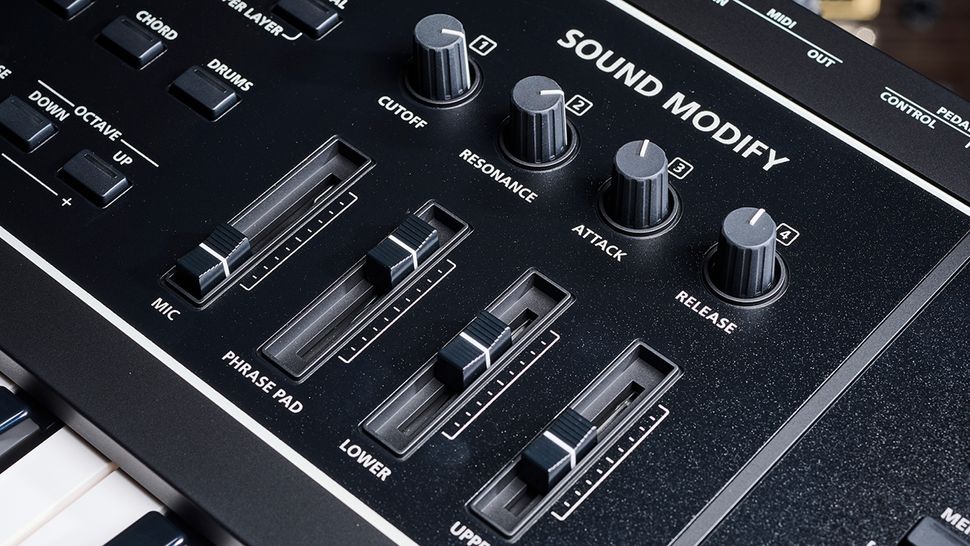Roland’s entry-level synth workstation is easy, light, and cheap, but has depth if you want it
The Roland Juno name has a complicated history, once a range of cheaper analogue polysynth alternatives to Roland’s more expensive Jupiters, with the original Juno-6, 60 and 106 becoming sought after by vintage purists.
However, more recent Junos have veered sharply away from these originals’ specs. Earlier this century the name returned; in Roland’s eyes it still meant ‘entry-level’ and not ‘vintage classic’, so was slapped on cut-down Fantoms and wavetable synths including a 2004 effort which was confusingly called Juno-D, as is the latest Juno on test here.
2022’s Roland Juno-X was a fantastic nod back to the original synths, though, but this latest 2024 Juno-D – available as a 61-note and 76-note ‘synth-action’ D6 and D7, and an 88-note weighted hammer-action D8 – is a nod back to that entry-level philosophy. Don’t expect vintage analogue then (unless you dig deep and digitally), but do expect a lot of features wedged into its lightweight design, and a lot of bang for buck.
Juno-D is one of those keyboards aimed at players and performers, the likes of which really are packed to the rafters with sounds, sequencing, playing options and (if you want it) more depth. Mostly, though, it’s about simply playing from a mighty 3,800 ZEN-Core sounds (easily selectable by category) and 95 drum kits, all of which which can be played as individual single tones, or layered patches (commonly as two parts).
Multipart ‘scenes’ can also be set up where up to seven tone parts plus percussion can be created with editable parameters like keyboard ranges and velocity curves, plus more obvious tweakable (via sliders) volumes for each part. Handily, these can act like multitimbral setups by changing each part’s MIDI receive channel. Another plus is that all tones in the Juno-D can also be sent to or loaded in from Roland’s ZEN-Core desktop software.
The sounds at the core of Juno-D are just the start though, as you get many other features including a decent sequencer – not exactly fulsome with a maximum of just 64 steps and few quantise options, but it is very (very) easy to use. There are also lots of effects (93 each of multi and insert), chord memories, rhythm patterns and arpeggiation. A Phrase Pad area wraps the more instant of these up into one section, with four simple buttons and eight pads to select beat segments, sequences and an overview of scene mixes.
There’s even a fair bit of synthesis power under the hood should you wish to dig, but you will have to wade through pages of, albeit fairly simple, menus, made easier to navigate by the super, large screen. Hands-on controls to change parameters are limited though – you get four rotaries to change obvious filter parameters (plus secondary assignments on hand for EQ and more). With many other sonic parameters rather buried, this isn’t a synth for easy synth tweaking on anything more than a basic level; it’s more a keyboard for surfing many a sound and playing or accompanying.
And really Juno-D is all about accessing these quality sounds fast and setting up live multiparts and sequences. It loads them in with no fuss or delay and it sounds as good as you undoubtedly expect – realistic when needed, although not as layered and nuanced as a many-gigabyte software instrument might be.
Synths and pads are good with some multipart setups complex and evolving. Even those set up for modern (ish) genres like drum & bass aren’t as embarrassing as these might have been back in the early 2000s! These scenes obviously lend themselves to parts for individual song performances during a gig – simply dial, sequence or play – and while this keyboard does much more, and could be mistakenly seen as a jack of many trades, its strengths as a performance and player’s machine should not be underestimated.
Juno-D is doing a lot, then, covering many performance functions that a gigging player needs and in a very portable keyboard – it’s solid, but at 6.8kg (15lbs) the D7 is lightweight enough to take from venue to venue (and the D6 only weighs 5.8kg). It is a good, if slightly unexciting entry in Roland’s keyboard lineup, then, a great performer with synth aspirations if you like, and while it is aimed at (and a very decent option for) beginners to the workstation ethos, it is also a solid choice for a variety of other tasks if you want to dive in. But its biggest attraction is the price as it delivers a lot of high-end workstation power – and much from the pricier Roland Fantom range – in a more cost-effective, lightweight, albeit cut-down package.
Verdict: A great synth workstation for those new to the genre, with some hidden extras for more experienced players, and all at a very keen price. Just don’t expect a 1980s’ Juno.
Roland Juno-D7: Hands-on demos
RolandChannel
Loopop
Merriam Music
Khordmaster
Roland Juno-D7: Specifications
- KEY FEATURES: Keyboard: 71 Velocity-sensitive keys; polyphony: 128 voices; parts: 7 tones plus percussion; engine: ZEN-Core includes 3,800 presets and 95 drum kits which are expandable via Roland EXZ; 128 Scenes (multiple parts) plus 128 user; effects: 93 multi and insert effects, 6 drum compressors, master EQ, chorus and reverb (use an EQ or multi-effect per part); mic input for vocoder with noise gate, compressor and reverb effects; sequencer: real or step time, 8 tracks, 64 steps; rhythm pattern, arpeggiator and chord memory functions; display: liquid crystal colour (480 x 272 pixels); connections: USB (audio interface at 24 Bit / 96 kHz), 3 x 6.3 mm main and headphone outs, 2 x 6.3 mm pedal and footswitch, MIDI in and out, mic in XLR/TRS combo socket, stereo 3.5 mm line input, USB-A (for storage devices) and USB-C (for computer); power supply: via USB-C port and external PSU (included).
- DIMENSIONS: 1217 x 324 x 94mm.
- WEIGHT: 6.8kg.





